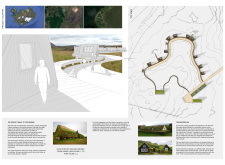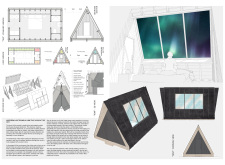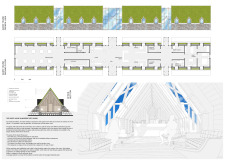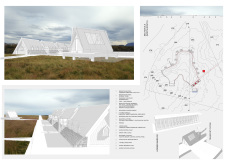5 key facts about this project
The primary architectural concept revolves around the idea of creating small, tent-like structures referred to as "Northern Light Rooms." These units are inspired by Iceland’s historical building forms, particularly the traditional tent designs used by nomadic communities and the character of the turf houses historically found across the region. This connection to the past is essential, as it grounds the modern design within the rich tapestry of Icelandic culture and structure.
Key aspects of the project include the use of materials that reflect both local availability and sustainability. The predominant material throughout the design is wood, which serves as the structural framework, providing a connection to Iceland’s natural resources and a sense of warmth within the interior spaces. In addition to wood, stone is incorporated into the foundational and decorative elements, anchoring the structures within the landscape. Green roofs are employed to enhance insulation while enabling the buildings to blend seamlessly with their environment. The large glazing panels are designed to maximize natural light and provide inhabitants with panoramic views, allowing them to experience Iceland’s dramatic natural beauty.
The site layout plays a significant role in the architectural vision, with careful consideration given to the landscape’s contours and views. The arrangement of the structures creates a sense of community while preserving individual privacy. A meandering pathway links the buildings, promoting exploration and engagement with the surrounding environment. This thoughtful organization enhances the occupants' experience and fosters social interaction among visitors, further enriching the significance of the project.
Inside each Northern Light Room, the spatial organization reflects practicality and comfort. The interior layout accommodates essential living functions, allowing for a balance between private retreat and communal spaces. The design prioritizes sustainability, featuring energy-efficient systems such as renewable energy sources, which significantly reduce the ecological footprint of the project. This emphasis on self-sufficiency enhances the overall architecture by aligning with contemporary environmental standards.
Another significant aspect of this project is the guest house, reminiscent of traditional turf houses yet designed with modern sensibilities. It serves as a communal hub where guests can gather, share experiences, and appreciate the aesthetic qualities of the architecture. The guest house provides essential amenities while creating a welcoming atmosphere that encourages interaction among guests.
The project's uniqueness lies in its ability to bridge historical and contemporary architectural practices, crafting spaces that engage with users while respecting the environment. This dual focus on architectural heritage and modern ecological practices exemplifies a nuanced approach to design that is particularly relevant in today's context. By addressing historical context and integrating sustainable methods, this architectural project offers a relevant model for future developments.
For those interested in understanding the intricate details and innovative solutions present in this project, exploring the architectural plans, sections, and designs will provide valuable insights into the design processes and ideas employed. The project presentation offers a comprehensive overview of the architectural elements that make this endeavor noteworthy, revealing the thoughtfulness and careful consideration that have gone into its development.


























